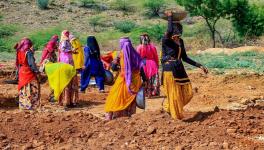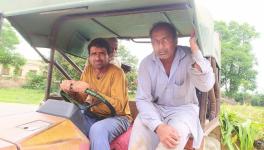COVID-19 in Rural India-XXV: Mameran’s Milk Supply Chain Shaken Amid Myriad Problems

Representational image. | Image Courtesy: PxHere
This is the 25th report in a series that provides glimpses into the impact of COVID-19-related policies on life in rural India. The series, commissioned by the Society for Social and Economic Research, comprises reports by various scholars who have been conducting village studies in different parts of India. The reports have been prepared on the basis of telephonic interviews with key informants in their study villages. This article talks about how the lockdown has disrupted the milk supply chain in Haryana’s Mameran. Its villagers face a cash crunch with no ATMs or banks in sight while daily wage labourers face a precarious future.
The lockdown enforced due to a growing number of people affected by the novel coronavirus pandemic has stunted agriculture and the rural economy in Mameran village from Sirsa district in Haryana.
The total population of the village is 4599; there 2455 males and 2144 females (as per the Socio Economic and Caste Census 2011). The Jat community is dominant in the village and other communities present include Baniyas, Kumhars, Meghwals, Nayaks, Majahbis and Bajigars.
The Rabi crops of Mameran are wheat and mustard. According to a farmer, they have been unable to hire labour and equipment due restrictions on movement owing to the lockdown, and are facing hurdles in harvesting their crops as a result. Another farmer said that the combine used for harvesting crops in Mameran usually comes from Punjab. Due to the lockdown, the machine has not yet returned to the village from other states (Madhya Pradesh and Gujarat) where it is also put to use, delaying harvesting in Mameran.
Impact on crops
Vegetables grown in the village include cabbage, chickpea, tomato, potato, capsicum, cucumber and green chili. The farmers were worried if they will be able to sell their crops at all and whether they would get a good price for them. At the time of correspondence, vegetable farmers were selling their crops at low prices with no means of storing the perishable commodities.
One of the farmers said that cabbages were being sold at the mandi for three to four rupees a kilo—the same produce would have fetched between eight to ten rupees per kg in normal times. Another farmer abandoned three acres’ worth of cabbage as the price being offered for it would not have even covered the cost of harvesting. Yet another said that the price of chickpea had fallen from Rs 25 per kg to between Rs 15 and Rs 17 per kg.
The milk situation
Milk supply in Mameran usually involves three players: the individual milk producer, generally a small farmer in the village; the middleman, usually a dairy owner in the village or in the city; and the district-level dairy plant. A milk producer said that the high price of milk about three months ago (approximately Rs 72 per litre for milk with 10% fat) had led many producers to purchase more cows and buffaloes.
Then, the VITA dairy plant in Sirsa procured more than two lakh litres of milk per day. However, after the lockdown began, procurement by the plant had come down to half, about one lakh litres per day, due to a decrease in demand for dairy products like ghee, curd, butter, paneer, lassi, kheer and sweets – items typically in demand for public functions like ceremonies and marriages. This affected middlemen and small individual producers in the village. One of the middlemen, who said he used to sell 1000 litres of milk every day to the plant before the lockdown, mentioned the number was down to 600 litres of milk per day. With no demand, the price of milk with 10% fat had declined to less than Rs 60 per litre. A milk producer said that even milk with four percent fat, which used to be sold at Rs 35 per litre was being sold at less than Rs 25 per litre.
The majority of the village’s inhabitants are self-employed cultivators, and therefore less precariously placed during the lockdown than those who are self-employed in non-agricultural occupations, such as tailors, barbers, mechanics, electricians, plumbers, shopkeepers, masons and informal workers and casual labourers in the unorganised sector. The village sarpanch said that between 10% and 15% of the village’s inhabitants are daily-wage earners who travel outside the village to the nearby city of Ellenabad, or the district headquarters at Sirsa to work. A mason from the village said that he used to travel to nearby villages and cities for work, but the lockdown has restricted his mobility and he had lost his job.
Approximately one thousand residents of the village are registered under the MGNREGA scheme. One of the workers said that since there was no MGNREGA work during the lockdown, workers had not benefitted from an increase in wages announced by the finance minister as part of the government’s relief efforts. The state government of Haryana had announced financial support of Rs 1000 per week for casual labourers, street vendors and rickshaw pullers; the amount is to be deposited directly into their bank accounts. In addition, the Centre had announced that BPL families would be provided rations (including rice, wheat, mustard oil, one kg of sugar) free of cost for the month of April. But none of those spoken to had received any of the relief measures which had been announced. PDS cardholders said they had received only five kgs of wheat per person per month during the lockdown..
During the first two weeks of the lockdown, shops selling essential commodities like bakeries, vegetable and grocery stores were open for four hours from 10 a.m. However, from the third week of the lockdown, these shops were open on alternate days, and during specific time slots. Chemist shops are open from 10 a.m. to 5.00 p.m. While petrol pumps were open from 7 a.m. to 7 p.m., milk booths were open between 8 a.m. to 11 a.m and again between 6 p.m. and 9 p.m. Vegetable and fruit vendors were allowed to sell their produce for seven hours from 9 a.m.
No liquid money
Villagers in Mameran were also finding it difficult to access cash to meet their daily needs. A villager said that while they could borrow money from local shopkeepers earlier, they were refusing to lend cash because of a cash crunch. The nearest bank branch is six kms away, in Ellenabad. Villagers suggested that mobile ATMs could be made accessible to them in the village.
A village council member (panch) from the village said that the panchyat was enforcing the lockdown by getting together a team of youngsters to guard village boundaries and restrict the entry of outsiders. The village is also regularly sanitised. According to the village head, no one was under home quarantine in the village or the block, and no one has tested positive for COVID-19 either.
However, villagers said that the village does not have a Primary Health Centre or a public dispensary and there was only a quack who they consult for minor ailments. Villagers who require serious medical care have to travel to the Government Hospital in Ellenabad. It has been difficult for the poor and the ill to travel during the lockdown, both due to a lack of transport and the means to travel.
The COVID-19 lockdown has put casual workers and daily wage earners into a financially precarious situation; farmers are anxious about their harvest being delayed; individual milk producers and middlemen involved in the dairy supply chain have been hit by the fall in demand; vegetable producers are unable to sell their produce at good prices; those dependent on the PDS, MGNREGS and other government schemes are largely yet to receive the relief promised by both the state and central governments.
Harmanender Singh is an Assistant Professor with the Department of Economics at the Akal University in Bathinda, Punjab
Get the latest reports & analysis with people's perspective on Protests, movements & deep analytical videos, discussions of the current affairs in your Telegram app. Subscribe to NewsClick's Telegram channel & get Real-Time updates on stories, as they get published on our website.
























